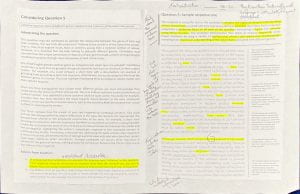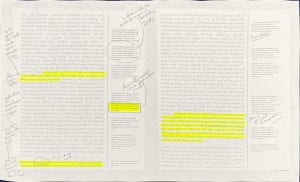Please use the comments below (and the individual comments on your work once it’s returned to you) to set targets and prepare effectively for your Semester 1 examination. Note that these comments can be equally applied to any question on any text and aren’t restricted to High Noon or The Dressmaker.
In effect, these comments work for ALL questions and ALL texts in the Responding Section of your ATAR examination.
Use them to re-write responses, to work formatively, to set targets.

Task 4- Responding (Comparative)
Please note the comments below and use them to set personal targets in advance of your Semester 1 examination.
Strengths
- Where responses were at their most successful, there was a clear focus on all elements of the question, there was sufficient focus on specific scenes and/or characters, there was an appreciation of how they were constructed and how their construction invited a specific response from a viewer.
- Effective responses were characterised by sophisticated academic discourse, strong thesis statements, topic sentences which logically and cohesively extended from the thesis statement and backed up by a confident knowledge of the texts.
- Effective responses were detailed and sustained. While the most effective responses won’t always be the longest ones, there is an expectation that an extended response is precisely that.
- The most effective responses demonstrated a competent understanding of how these extended responses will be assessed.
Areas for Development
- Spell titles of texts correctly. High Noon and The Dressmaker. Spell the names of characters correctly. It doesn’t inspire confidence in your response if you make avoidable errors such as these. Underline titles of texts please.
- Refer to the genre of each text in your introduction.
- I got the impression from some responses that the understanding and engagement with each text was very limited.
- Establish strong links in your introduction by using the appropriate discourse markers.
- Topic sentences should be focused and should build on the clear and focused argument promoted by the thesis statement.
- Mise en scene (translated: everything that’s in a scene) is an umbrella term for a host of specific features in a visual text. You’re better off being more specific (props, costumes, framing, posture, facial expression etc) and exploring how different elements combine to position a response from a viewer.
- The most effective responses were those that offered a focused analysis of specific scenes/points in each text and then explored how the construction of these invited a specific response from the viewer.
- It’s important to explore the function of these texts and how their construction is used to promote particular ideas about the context of production.
- ‘Viewer’ is a more appropriate term, rather than ‘audience’. It implies a more analytical approach, rather than the more general ‘audience’. You can also use the term ‘When reading this text, …’ which also invites an active engagement with the text rather than a more passive ‘viewing’.
- The Dressmaker isn’t a Western. It is a revenge comedy which borrows from the Western genre.
- While context (particularly the context of production) is important, you mustn’t allow yourself to become side-tracked by it. When that happens, you lose sight of the texts themselves which can lead to a rather superficial response.
- Academic discourse, the language you use to establish and develop your argument, should be sophisticated. Quite a few responses could be considered too informal in the ways in which points about each text were addressed.
- It’s essential that you establish a clear and unambiguous argument in your thesis statement which is then developed in a clear and logical manner through your topic sentences. In many responses, the lack of a clear thesis statement in relation to both texts and question, lead to an unfocused and largely general treatment of each text. In other words, if you fail to get your introduction right, the success of your response is compromised at this point.
- General character and plot overview will not get you across the line in ATAR English. You need to be able to demonstrate that characters are constructed, and it is their construction which promotes particular attitudes and values, invites a specific response from the audience and is, in many cases, a reflection on the context in which the text was produced.
- Some responses were far too brief.
- Question 3 asked you to explore how the texts appeal to ‘certain audiences’. The most effective responses defined who those ‘certain audiences’ were. However, less effective responses treated the concept of audiences in a very general manner. This was a key discriminator in the responses to this question.
- Some body paragraphs were quite limited in scope. There were opportunities to extend/develop your ideas and in many cases, these simply weren’t taken. Your argument and insight into the texts needs to be detailed and sophisticated.
- Body paragraph 1 needs to promote your strongest argument, ideally.



